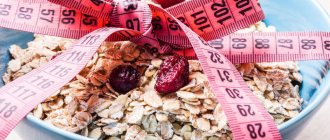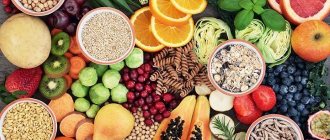In pursuit of a slender, toned body, both women and men are ready to take radical measures. To achieve a beautiful figure, they not only exhaust the body with training, but also try all kinds of diets.
Many of them involve extreme nutritional options, which is why the phrase “fast carbohydrates” is terrifying. It seems that these products are immediately stored in fat on the sides and other parts of the body. But is this really so, let's figure it out together.
What are simple (fast) carbohydrates
Carbohydrates are the “fuel” for all processes occurring in our body. They are found mainly in products of plant origin. Fast carbohydrates are simple compounds that require minimal energy to process, and their special formula allows them to be easily broken down and quickly absorbed.
Fast carbohydrates quickly enter the bloodstream, causing a sharp increase in glucose levels. It begins to be actively processed into energy, and if it cannot be completely used up (one cake is equivalent to an hour of physical activity), the calories are stored in fatty tissue.
But this is not the only reason for excess weight. After sugar levels drop, insulin continues to actively circulate, causing the body's need for nutrients to increase significantly. Therefore, often after eating foods high in simple carbohydrates, after 30-40 minutes the feeling of acute hunger occurs again.
To feel cheerful and full of energy, to maintain youth and beauty, you need to eat a balanced diet. Your daily diet should include proteins, fats and carbohydrates. The latter cannot be excluded from the menu, but do not forget about the interchangeability of many products. Honey and fructose are considered healthy sugar substitutes. If foods contain the same amount of carbohydrates, the choice is made in favor of the food that will have a beneficial effect on the body.
It is recommended to consume foods rich in easily digestible carbohydrates in the first half of the day, preferably in the morning. It is believed that it is during this period that the body is able to quickly and easily process glucose into energy.
Even fruits and berries contain a large amount of simple sugars, so it is advisable to eat them before 6 pm, otherwise they will contribute to excess weight gain. And people who want to follow the rules of a healthy diet reduce their intake of foods containing fast carbohydrates to a minimum.
How to identify high-carbohydrate foods without delving into the chemical composition:
- rich taste and strong aroma;
- before reaching the final form for the consumer, many stages of processing go through, which negatively affects the quality;
- made using confectionery or bread flour;
- high sugar content (this can be both products with natural sugars and those that are artificially sweetened in production);
- Although the feeling of fullness comes quickly, it also quickly goes away, and the joy of eating is replaced by regret.
Nutritionists do not recommend outright abstinence from eating foods containing simple carbohydrates. On the contrary, they even advise including it in the diet, but only if 75-85% comes from food that is beneficial. Then “harmful” foods will not harm your health.
What are the benefits of simple carbohydrates?
According to studies, it has been proven that the presence of sugars allows the body to better absorb foods enriched with fats and proteins. Nutritionists and doctors have come to the same conclusion - the diet should include most of the slow substances, but when it is necessary to restore energy levels in an extremely short time, even for a short period of time, fast carbohydrates are simply irreplaceable. Due to the immediate increase in blood glucose, a surge in insulin is observed, and blood circulation becomes more intense. Muscle tone also increases significantly.
The table of products containing easily digestible elements offered on our website will help you create a nutritious diet, taking into account the characteristics of your activity, the functioning of the body and the goals being achieved. These food components are distinguished by their ability to:
- eliminate dizziness and faintness;
- help get rid of attacks of nausea;
- activate the functioning of the brain when solving complex issues and problems;
- replenish glycogen reserves;
- neutralize toxins;
- assist cells in building a framework;
- provide assistance in the fight against stress and depression.
With regular visits to the gym and intense exercise, easily digestible carbohydrates are also very useful, but in small quantities.
Use our table to calculate the simple and complex carbohydrates you consume, which will help you recover after workouts, achieve your goals in shaping your figure, and improve your well-being in certain cases.
Glycemic index
The glycemic index (hereinafter GI) is a value that evaluates the rate at which carbohydrates are broken down by the body and how this affects blood sugar levels.
In nutrition, this term appeared thanks to a doctor from Canada, David Jenkins. At first, the doctor’s goal was to create a diet suitable for people with diabetes. He conducted research looking at how sugar levels changed after eating different foods.
Based on this, he proved that a person’s well-being directly depends on the amount of carbohydrates in the food he consumes. If the blood sugar level does not exceed the established norm, then a surge of energy and strength is felt, and attention and performance increase. When the glucose level deviates from the norm (to a lesser or greater extent), a loss of strength appears. To maintain normal well-being, it is simply necessary to control and maintain this indicator within established limits.
Scientists have developed a GI scale, in which all food is divided into three groups:
- high GI (> 70 units);
- average GI (55-70 units);
- low GI (
To ensure that excess carbohydrates do not go into fat reserves and that your mood is good, preference is given to foods with low GI. They take a long time to digest, so the feeling of fullness is maintained for several hours.
Possible harm and contraindications
The danger of easily digestible carbohydrates is increased body weight. When you lead a sedentary lifestyle, energy turns into fat. Other negative effects of substances on the human body include:
- Pancreas overload. The body is forced to produce an increased amount of insulin and wait for the next intake of carbohydrates. When working in this mode, the iron wears out, which can lead to the occurrence of malignant tumors.
- Disruption of the nervous system. Increasing blood sugar levels increases the production of serotonin, which ensures a good mood. After eating carbohydrates, a person feels uplifted, but over time a feeling of depression arises.
- Disturbance of intestinal microflora. Simple carbohydrates change the acid-base balance, creating conditions for the proliferation of pathogenic microorganisms. The functioning of the immune system is disrupted, and infectious diseases begin to occur frequently.
- Diabetes. The breakdown of disaccharides requires a large amount of insulin, the breakdown of fat slows down and the absorption of glucose is impaired.
- Hypoglycemia. A sharp refusal to eat easily digestible carbohydrate foods contributes to the appearance of weakness, decreased performance and the development of anemia. The person becomes irritable and suffers from dizziness and headaches.
- Carbohydrate addiction. Sweet tea and cookies relieve hunger for a short time. Eating a balanced meal at lunchtime does not contribute to satiety, because the body requires carbohydrates. Therefore, a person has a desire to eat candy.
- Cardiovascular diseases. Fat deposits narrow the lumens of the arteries, leading to the development of atherosclerosis.
- Caries. Eating sweet foods helps create an environment favorable for the growth of bacteria in the oral cavity.
Fast carbohydrates are not of particular value to the body, so their quantity can be limited.
The importance of fast carbohydrates in nutrition
Do not rush to give up fast carbohydrates with high GI. If consumed in moderation and with strict portion control, they can be beneficial to the body. Although foods with a glycemic index value of 70 or higher provide only short-term benefits, they can be useful because:
- activate brain activity;
- restore the reserve of carbohydrates, which is primarily used up during active exercise;
- fight depression by increasing the level of “happiness” hormones;
- perform a protective function, not allowing harmful substances to enter the body from the external environment.
Fast carbohydrates are a source of energy for athletes, as well as for people engaged in mental activity. They increase endurance, improve brain function, and stimulate concentration.
Fast and slow carbohydrates - what's the difference?
Carbohydrates are complex chemical compounds that are important components of cells. According to structure and structure, they are divided into two large groups:
- Fast (or simple). The rate of breakdown and absorption of such carbohydrates is much higher than slow ones. They easily enter the blood, but the feeling of satiety is quickly replaced by a feeling of hunger due to a sharp jump in insulin. These include products containing glucose, fructose, lactose, sucrose or maltose. These are flour, confectionery products, sugar, carbonated drinks, alcohol.
- Slow (or difficult). They are characterized by a low rate of absorption: it can take the body up to four hours to digest food containing such carbohydrates. Throughout this time, a person feels full. For this they are also called “long” or “long”. This group includes products containing starch, fiber or pectin, glycogen. These are whole grain cereals, bread, pasta, vegetables, unsweetened fruits, herbs, and meat products.
When planning your diet, it is recommended to focus on slow carbohydrates. They provide a long-lasting feeling of satiety, good health, a boost of vigor and energy. But you shouldn’t give up fast carbohydrates completely, as this can lead to breakdowns. Nutritionists allow the addition of favorite, but “harmful” foods to the diet, provided that 85-90% is healthy food.
The benefits and harms of carbohydrates
Many women, and men too, know firsthand that low-carb diets lead not only to the loss of hated kilograms, but also take away strength and worsen well-being. Preference should be given to slow carbohydrates. Products that contain them are often rich in vitamins and other beneficial substances. Why carbohydrates are the basis of the body’s vital functions:
- participate in the construction of protective skin cells, as well as in the formation of cartilage, ligaments, and the formation of enzymes;
- play an important role in the functioning of the central nervous system;
- help in the development of muscle mass, protect muscles from destruction;
- this is the main source of energy that quickly and effectively replenishes the energy reserves stored inside the muscles and liver;
- support the functioning of vital systems, including regulating the activity of the gastrointestinal tract, helping to cleanse the intestines, restoring and maintaining the balance of its microflora.
If you consume too many carbohydrates, they will not have time to be converted into energy, so they will accumulate in the body in the form of fat deposits. Problems such as the development of caries, swelling, changes in blood pressure, dermatitis, etc. may also arise.
What are carbohydrates and why do the body need them?
In 1827, the British physicist William Prout first suggested that a person needs exactly three groups of macronutrients to live. Macronutrients include three groups of main energy sources necessary for the functioning of our body. These are carbohydrates, proteins and fats.
Micronutrients include groups of vitamins and microelements. They do not carry calories, have no energy value, but are the most important components of the life of biochemical reactions and cofactors of enzymes.
Carbohydrates
is a group of organic compounds that consist of carbon atoms and OH hydroxyl groups. Up to 80% of the dry mass of plants and all biomass of the earth is carbohydrates. Representatives of the animal world, including humans, are not capable of synthesizing carbohydrates from inorganic compounds; only plants are capable of this. Carbohydrates make up up to three-quarters of plant mass. Carbohydrates are also present in the human body, but they do not form the majority; they are represented in only 2% of the structure of the human body.
Functions of carbohydrates:
- Energy
- carbohydrates are the main substrate for energy production. 1 gram of carbohydrate produces 4 kcal.
- Structural
- carbohydrates are an important structural element, a component of membranes.
- Storage function
- one of the deposited sources of energy, which is contained in the liver and muscles - glycogen.
- Regulatory function
— the pituitary hormones thyrotropin and gonadotropin are glycoproteins, that is, they are two components: a carbohydrate and a protein part.
- Protective
- Glycoproteins are antibodies, very important components of the human immune system.
- Receptor
— Glycoproteins form the cell’s receptor apparatus.
- Information function
— the key components of RNA and DNA are carbohydrates, ribose, and deoxyribose.
According to the classification, carbohydrates can be divided into simple and complex
.
Simple
: monosaccharides, oligosaccharides. Monosaccharides have only one ring molecule in their composition. These include: glucose, fructose, galactose. Oligo - This root means small, small, or of few components. These include substances such as sucrose, lactose and maltose. Consist of two cyclic molecules. Simple carbohydrates are water soluble, sweet in taste and quickly absorbed. They are always a fermentation substrate, have a high glycemic index and therefore cause insulin spikes (except for fructose).
Complex carbohydrates
, as a rule, are polysaccharides, poly is many, which consist of many ring molecules of monosaccharides. For example, starch, glycogen. Complex carbohydrates dissolve slowly in water and have no taste. In the intestine, complex carbohydrates are absorbed slowly, so they have a lower glycemic index and do not cause such strong insulin spikes, unlike simple carbohydrates. Complex carbohydrates can also have a mechanical effect on the intestines.
How many carbohydrates do we need?
The amount of carbohydrates in the daily diet depends on many characteristics of a person: gender, age, lifestyle, etc.
So healthy people who are not on a weight loss diet, with an average level of activity, need to consume 4.5-5.0 grams of carbohydrates for every kilogram of their weight.
Those who engage in heavy physical labor or intense training require more carbohydrates, so this figure is increased to 8 g per kilogram of weight. For people leading a sedentary lifestyle, it will be enough to consume 3.5-4.5 g of carbohydrates/kg of weight.
To lose weight, the amount of carbohydrates is determined by calculating the daily calorie content of proteins and fats:
- proteins and fats in grams are multiplied by 4 and 9, respectively;
- summarize the resulting numbers;
- the result is subtracted from the daily calorie intake;
- the resulting number is divided by 4 - this is the norm of necessary carbohydrates.
In any case, the amount of carbohydrates consumed per day should not be less than 100 grams (slow ones account for 70-80%, fast ones - 20-30%).
Diet with limited digestible carbohydrates
The basic principles of such a diet include the following recommendations:
- Eating enough food containing proteins and fats. These products include eggs, lean meats and fish, nuts, sunflower seeds, whole milk, and dairy products.
- Maintaining insulin production. To do this, the amount of carbohydrates consumed must be at least 1 g/kg of a person’s weight.
- Reducing the amount of simple carbohydrates. Easily digestible foods are included in the diet in minimal quantities. In this case, you need to take into account the glycemic index of foods. It is better to exclude confectionery products from the menu.
- Compliance with diet. Food is taken 5-7 times a day in small portions. Breaks should be no more than 4 hours. Otherwise, protein deficiency develops, which contributes to rapid weight gain.
- Compliance with food preparation rules. Products need to be steamed, boiled or baked. Vegetables are good to eat fresh. Smoked, fried and pickled products, and baked goods should be avoided.
By following such recommendations for a month, a person can achieve stabilization of metabolic processes and get rid of excess weight. The diet normalizes the functioning of the pancreas.
What foods are classified as fast carbohydrates: list of foods
To prevent the development of obesity, it is better to introduce easily digestible carbohydrates into the diet in small quantities. Focus on the list of products that contain fast carbohydrates:
- sweets from the store (marmalade, chocolate, carbonated drinks, ice cream, waffles, etc.);
- bee products;
- fruits;
- sugar (especially refined);
- sausages;
- zucchini caviar;
- canned fruits (apricots, peaches, pineapples);
- alcohol;
- potatoes in any form;
- condensed milk;
- starch;
- fast food;
- baked goods made from white flour;
- pasta;
- vegetables that are steamed or amenable to short-term scalding (as easily digestible starch appears in them);
- dried fruits;
- jam and confitures;
- instant and semi-finished products;
- cereals, etc.
The fast carbohydrates listed in the list can be consumed after physical activity, then the body will recover faster and the person will feel a surge of strength and energy. But when creating a menu, nutritionists recommend focusing not only on this list, but also on the glycemic index.
Many products that we are accustomed to consider healthy for our figure (muesli, yogurt, breakfast cereals, energy bars, etc.) contain prohibitive amounts of sugar, as they are designed to quickly satisfy the feeling of hunger.
Vegetables can also contribute to gaining extra pounds, so people on a diet are advised to remove sweet carrots, beans, pumpkin, etc. from their diet.
Simple carbohydrates, insulin, insulin resistance and diabetes
To digest carbohydrates, you need insulin, a pancreatic hormone that promotes the absorption of simple sugars into the blood. Direct absorption is carried out by the villi of the intestinal mucosa. Insulin increases the permeability of the cell membrane and transports glucose into the cell. In the case when the cell does not need glucose, the pancreatic hormone sends it to the liver for storage in the form of glycogen. Biochemical mechanisms involving insulin implement the process of converting some amount of glucose into fatty acids.
Low glucose readings—hypoglycemia—indicate that there is too much insulin. At this time, muscle and nerve fibers experience sugar hunger. If insulin levels are too low, glucose levels rise—hyperglycemia. In this case, sugars are not absorbed by cells and remain in the blood. Chronic hyperglycemia causes damage to the heart, nerve fibers, brain, kidneys, and eyes.
Insulin resistance is a condition that occurs when the body does not respond to the activity of the pancreatic hormone. With excess weight, hypertension, and a sedentary lifestyle, cells lose the ability to recognize insulin.
With the constant consumption of fast carbohydrates, a kind of vicious circle is formed. An excess of carbohydrates leads to a spike in blood sugar. Following this, the concentration of insulin increases, which causes a feeling of hunger and fatigue. To suppress appetite, new portions of carbohydrates are required. Chronic overeating inevitably leads to excess weight. Insulin resistance is the main cause of type II diabetes mellitus.
Type II diabetes mellitus and fast carbohydrates are incompatible. Simple sugars are quickly transformed into glucose. Their presence on the menu does not allow you to control blood glucose levels. With insulin resistance, the body is not able to utilize excess glucose, and the consumption of fast carbohydrates constantly maintains its high level.
Table of fast carbohydrates in foods with a high glycemic index (above 70 units)
Let's consider which foods are classified as fast carbohydrates with a high glycemic index.
| Product | Average GI (units) | Amount of carbohydrates per 100 g of product (grams) |
| Watermelon | 75 | 8 |
| Bakery products | 80 | 50,61 |
| Jam, jam, apricot compote | 90 | 58 |
| Swede | 100 | 7,7 |
| Zucchini (fried) | 80 | 11,2 |
| Zucchini caviar | 85 | 8,2 |
| Fried potatoes, fries | 85-90 | 24 |
| Baked potatoes | 100 | 20 |
| Mashed potatoes | 95 | 13,8 |
| Potato chips | 88 | 49,7 |
| Canned vegetables | 75-80 | 34,0 |
| Cornflakes | 90 | 82,2 |
| Boiled carrots | 80 | 5,22 |
| Parsnip | 85 | 17,99 |
| Beet | 75-80 | 8,8 |
| Pumpkin | 80 | 6,50 |
| Dates | 105 | 69,3 |
| Rose hip | 100 | 3,4 |
| Carbonated drinks | 100 | 10,42 |
| Semolina | 75-80 | 78,0 |
| Legumes | 85 | 19,65 |
| Rice flour noodles | 95 | 80,18 |
| Bee products | 90 | 82,4 |
| Pasta | 75 | 75,0 |
| Instant cereals | 85 | 66,27 |
| Dumplings | 75 | 13,5 |
| Wheat flour | 85-90 | 76,3 |
| Condensed milk | 80-85 | 54,4 |
| Curd cheeses in glaze | 75-80 | 32,6 |
| Juice | 75 | 11,82 |
| Celery | 85 | 2,1 |
| Sugar | 105 | 99,98 |
| Muesli of different varieties | 70-75 | 74,9 |
| Crackers | 75-80 | 66,4 |
| Chocolate candies | 80 | 34,18 |
| Turnip | 85 | 5,06 |
| Halva | 70-75 | 60,49 |
| Shawarma | 70-75 | 24,6 |
| Cottage cheese pancakes | 75 | 18,2 |
| Wheat bread | 75-80 | 48,3 |
Remember that these products do not provide the body with useful substances, and they satisfy hunger only for a short time. Their excessive consumption negatively affects overall health.
Carbohydrates and ketosis
Ketosis is the body's response to the complete absence of carbohydrates. With an acute deficiency of saccharides, the process of compensating for the missing energy begins by breaking down fat depots.
There are keto diets that help achieve positive results:
- Stabilize insulin and glucose in the blood.
- Reduce dependence on carbohydrates.
- Control your appetite.
- Maintain a feeling of satisfaction and satiety for a long time.
In a state of carbohydrate deficiency, the body learns to obtain glucose from internal tissues. The liver starts the process of transformation of protein amino acids and glycerol, which are contained in fatty acids - gluconeogenesis.
The keto diet allows for the consumption of small amounts of complex carbohydrates, but their volume usually does not exceed 25-50 grams per day. Errors in the diet, consumption of fast carbohydrates, too much slow polysaccharides take the body out of the ketosis state and do not give the desired therapeutic result.
Table of fast carbohydrates in foods with an average glycemic index (55 - 70 units)
In the table below, you will see which foods are fast carbohydrates with a low glycemic index.
| Product | Average GI (units) | Amount of carbohydrates per 100 g of product (grams) |
| A pineapple | 65 | 12 |
| Bananas | 55 | 22 |
| White grapes | 55-60 | 16,8 |
| Red grapes | 65 | 17,2 |
| Black grapes | 64 | 17,5 |
| Melon | 65 | 8 |
| Raisin | 64 | 79 |
| Boiled potatoes | 60-65 | 17,1 |
| Sweet potato | 55 | 20 |
| Kiwi | 55 | 15 |
| Boiled corn | 69 | 18,58 |
| Canned corn | 60 | 12,2 |
| Mango | 55-60 | 15 |
| Papaya | 59 | 9,12 |
| Black Rowan | 60 | 10,9 |
| Fruit salad with whipped cream | 55-60 | 38,18 |
| Boiled beets | 65 | 8,8 |
| Persimmon | 55 | 34 |
| Orange juice in bags | 60-65 | 13 |
| Yogurt with sugar and fruit | 59 | 3,6 |
| Tea or coffee with sugar | 60-65 | 7 |
| Canned vegetables | 65-70 | 33,96 |
| Sweet compote | 60 | 8,9 |
| Mayonnaise | 59 | 0,6 |
| Sour cream | 55-60 | 3,2 |
| Buckwheat | 60 | 72 |
| Cheese | 55-60 | 1,3 |
| Hercules flakes | 65-70 | 61,8 |
| Ketchup | 55 | 26 |
Low GI foods promote weight loss, guarantee a good mood and a feeling of lightness throughout the day.
Now you know what fast carbohydrates are and what foods belong to them. Don’t forget that everything is good in moderation; when creating an individual nutrition plan, try to maintain a balance. Combine simple carbohydrates with complex ones - add a handful of dried fruits or a spoonful of aromatic honey to oatmeal. Eat right and be healthy!
It will also be interesting
- The most expensive cosmetics in the world
- 12 Ways to Improve Digestion with Ayurveda
- Black cumin oil: properties and applications
- Jojoba oil: application
- Winter skin care.
Are fast carbohydrates always harmful? When is the best time to use them?
The optimal time to consume foods or drinks with fast carbohydrates is the first minutes after sports activities or training. Simple saccharides trigger a reaction that converts glucose into fats through the action of insulin. Physiologically, insulin levels always increase after eating. After physical activity, hyperinsulinemia directs glucose, amino acids, and creatine into muscle cells. In this way, glycogen reserves are restored.
After sports training, the so-called anabolic window opens. Without enough carbohydrates, glycogen is utilized in the muscles. Muscles need saccharides to replenish energy.
Simple carbohydrates provide sufficient glycogen supply to maintain muscle tone and health. They are quickly absorbed and cause an almost lightning-fast release of energy. For example, athletes who participate in long marathons drink drinks with fast carbohydrates throughout the race. Simple saccharides cause an energy surge, restoration of glycogen levels in the muscles, without affecting body weight in any way.
Fast carbohydrates after physical and sports activities protect skeletal muscles from catabolism - the breakdown of specific muscle protein. The protective property is realized by increasing insulin levels. It is insulin that prevents the breakdown of muscle protein. Eating fast carbohydrates immediately after sports is the easiest and most affordable way to stop destructive mechanisms.
Simple sugars not only preserve muscle protein. With the help of fast carbohydrates, new muscle cells are synthesized and muscle tissue is renewed. Muscles, like any organ, need nutrients to ensure their growth. Insulin is an anabolic hormonal compound that stimulates tissue renewal and growth.
[Video] Dr. Breg - the best time to eat. What time to eat to lose weight:











